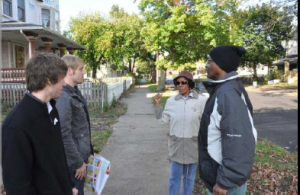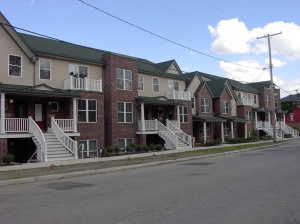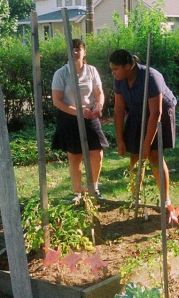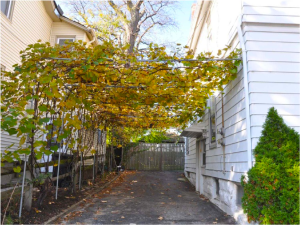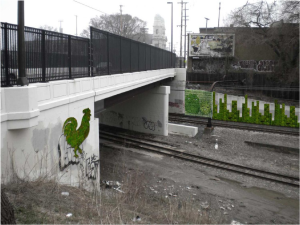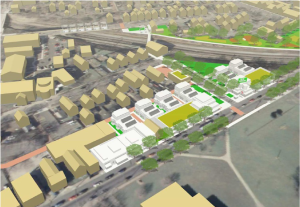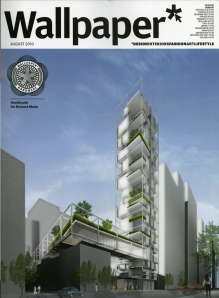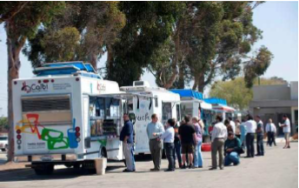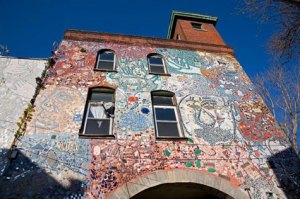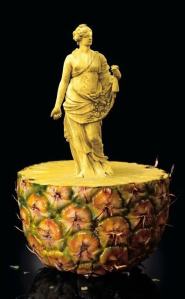 A few weeks ago, Kent State‘s Cleveland Urban Design Collaborative held a design charrette in Cleveland’s EcoVillage. I wrote a little about it then, but they hadn’t yet posted their images, so I didn’t go into too many details. They’ve posted their PowerPoint, though the report will be out later–check back on their website. The charrette involved their document and original research, a public meeting, informal conversations with neighbors who where out and about, and three days of furious designing, meant to help reinforce the EcoVillage’s credo: “To develop a model urban village that will realize the potential of urban life in
A few weeks ago, Kent State‘s Cleveland Urban Design Collaborative held a design charrette in Cleveland’s EcoVillage. I wrote a little about it then, but they hadn’t yet posted their images, so I didn’t go into too many details. They’ve posted their PowerPoint, though the report will be out later–check back on their website. The charrette involved their document and original research, a public meeting, informal conversations with neighbors who where out and about, and three days of furious designing, meant to help reinforce the EcoVillage’s credo: “To develop a model urban village that will realize the potential of urban life in
the most ecological way possible.” The EcoVillage was first conceived of as a model project, involving the construction of twenty townhouses on W. 58th St that were made from recycled
materials with careful considerations of energy usage (the first four units were built with solar panels), as well as several rehabs, additional cottages, a new solar-paneled RTA Rapid station, a solar-paneled school (Gallagher Middle School), bicycle paths and a community garden. These measures were meant to seed the neighborhood; developers earmarked numerous plots for further homes, but the recession hit and things stalled.
I moved in in 2003, amongst the first batch. Why? I’m not Miss Green by ideology (let me confess here that without Liquid Plumber clogged hair would create flooding in my bath in no time at all), but by default. I love the idea of solar power, and delighted at the thought my house might run on it. I like small houses, which coincided with the growing houses smaller idea. I don’t drive, so my carbon footprint is smugly smaller than most of my neighbors–but that’s because I don’t like
driving. I have no illusions about saving the planet, but I don’t have to make things worse. I suppose I’m a passive green–and like passive solar, it has plenty of benefits. Anyway, in the eight years I’ve lived here I’ve learned much more about my neighborhood, both good and bad. I love its diversity–Puerto Ricans, blacks & whites, Vietnamese, Appalachians, Guatemalans, Congolese and much more. I love its proximity to downtown and major transit routes (the RTA red line and the #22 bus). I love the physical beauty of St. Colman’s and St. Stephen’s, two of the most gorgeous churches in the city. I don’t like its crime (it’s mostly property theft; not that much is physical, and I still think we’re safer than Ohio City), or the number of registered sex offenders that live in the environs. I wish it were easier to get to the other side of Detroit Shoreway without a car, and wish someone would take my plea for a trolley that circles Detroit Ave, W. 25th, Lorain and W. 65th and run with it. And I grew tired of the visual grittiness that dominated the area. Does it have to be so grim looking?
No. And it could be a real neighborhood rather than just an artificial enclave. Many of the people who live within its boundaries don’t even know it. As noted at one of the public meetings, one resident had done a film on the EcoVillage, but didn’t realize he lived within it–that’s a big branding issue. Most neighborhoods evolve naturally and take on an identity defined by employment type (Columbus’s Brewery District or NYC’s SoHo), local landmarks (University Circle) or ethnicity (Little Italy, Chinatown). The EcoVillage as it had been was predominantly a gentrification scheme with noble ideals. Not to say that there weren’t buy-ins–Metro Catholic school at St. Stephen’s is teaching students about the environment, and has a garden; the church itself has launched a “Growing the Neighborhood” program that has refurbished a greenhouse, provided gardening q&a, held a

The EcoVillage's proximity to Gordon Square Arts District, the antique zone, W. 25th and downtown are all selling points for the neighborhood
plant swap and encouraged involvement among neighbors.
But a real neighborhood built around EcoVillage goals? One meant to realize the potential of urban life? It’s a tricky proposition in an area with a high percentage of renters who might have little investment in neighborhood. But renters can be highly invested! it all depends on the where, the who and the how. The Cleveland Urban Design Collaborative asked citizens about local spots that were important. The two landmark churches were mentioned, as was Zone Recreational Center, currently undergoing a circa $3 million eco-friendly renovation that will turn it into a model. I mentioned the Lorain Ave.

Some green walls are already in place. While some ivies and other vines can be hard on structural integrity, many modern green walls are built on a framework that protects the structure.
Supermarket, a convenience store that actually does act as supermarket to the many residents who rely on foot power for their shopping, and the CUDC folks, after their neighborhood walks, pointed out that neighborhood barbershops are likewise destinations and centers of community conversation.
With citizen input, research, and fresh sets of eyes, the Kent Students broke up into groups, dedicating themselves to varied goals. Their resulting designs were broken down as follows:
Identity and Wayfinding: These include ways to integrate residents into the concept of the EcoVillage, as well as to pitch it to visitors as an interesting, compelling, integrated neighborhood. CUDC suggested numerous strategies to encourage resident participation and ownership, including increased
commerce on Lorain, block systems, and ways of promoting education and heightening eco-identity. Some things are already in evidence and just need further encouragement, such as the use of native plants in yards and treelawns, green walls, larger and broader tree canopies (more difficult on north/south streets because of power lines), rain gardens, and forefronting some neighborhood assets, like brick streets (and considering exposing some that are tarred over). Banners and
innovative lighting, bird boxes on the RTA corridor, green rather than gang graffiti, and signage for key spots are easy but visible solutions. Some intriguing possibilities were raised, such as benches whose arms could incorporate solar cell phone rechargers, or an advertiser-sponsored solar bus stop that might provide a series of free WiFi signals up and down Lorain Ave., as well as on W. 65th. W. 54th was suggested as a great
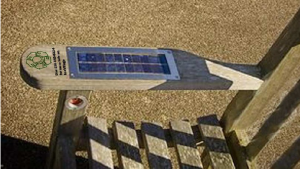
Based on a British design, what about benches that are branded and include info for neighborhood cell phone tours?
sample street, with St. Stephen’s (and some fabulous plantings) as a landmark. A quickly-embraced CUDC suggestion involved the use of fragrant trees, bushes and plants–factors that make strolls or bicycle rides distinctive and memorable. The two newly-vacant lots on Lorain at W. 58th could be transformed into temporary wildflower gardens until a potentially-commercial purpose emerges; these could be visually linked to wildflower scatters near the Lorain transit bridge, where greenery could provide a more attractive setting (note to councilman Matt Zone, highly involved in the proceedings–the sidewalks on the bridge are the iciest in winter, never snow free, and all puddle after a rain–perhaps some solar device or simply a better banked walkway could assist here).
Transit-Oriented Development (TOD): This concept relates to a density that isn’t yet present; TOD is meant to encourage use of public transit, both cutting down on fuel consumption and benefiting the many EcoVillage residents who are car-less. At the moment there are few benches and one bus shelter, despite wide Lorain sidewalks. While the new Rapid station is attractive and solar, it’s risky (someone tried to rob me at gunpoint on a sunny June evening there two summers ago)–it has a police mini-station but irregular staffing; it includes space for a coffee bar, but no proprietor takers yet. To accentuate the possibilities of creating a TOD, the Kent students proposed new mixed-use, phased construction of townhouses, apartments, and some low-rise commercial establishments
along Lorain (north) between W. 58th and W. 65th., so that it could reach a density of 26 residential units per acre–15 units per acre is the minimum for such a designation. Solar panels and green roofs, as well as additional trees and green spaces, would visually integrate it into the neighborhood.
EcoArc–Agrarian Resource Center: This was an intriguing idea for building

Espaliered trees are trained to grow along a flat surface--spartially easy for small greenhouses, easy to pick
neighborhood ties, identity, jobs, and community purpose. Building on the growing popularity of urban farming in Cleveland, this would center on the area bordering both
sides of the bridge at the Madison Ave. exit of the RTA rapid station. It would incorporate orchards, community gardens, a composting facility, an urban farm and a community kitchen. The kitchen would be a place of education as well as sales. I could picture a great interaction of produce and recipes here, but I’d love the addition of a winter greenhouse to provide fresh produce throughout the year. Espaliered fruit allows for maximization of small spaces, and these kinds of small production centers have been part of the American landscape since colonial times. We have a lot of residents with agricultural backgrounds–this sounds like a natural.
Lorain Ave Gateway: Recognizing that entry into the EcoVillage is not solely via the RTA, the CUDC suggested orienting visitors via a stretch of Lorain beginning at W 54th and extending across the RTA bridge. The cosmetic changes made here would visually enhance the neighborhood and help create its identity, as well as promote safety and a pedestrian level-
designed experience. I love the way the new crosswalks up along Detroit Ave at Gordon Square transform the walking experience,
and would love to see it something along similar lines here. The gateway idea would also mark the bridge with a living green wall and some wildflower sectors, again visually uniting it with the current empty lots astride the old grey building (currently looking like an old man’s last tooth) at W. 58th. Imagine them blanketed in native wildflowers! I will admit I’d want to be sure the situation did not imitate that of a grad school friend in Bloomington who transformed her large backyard into a “natural meadow”–she forgot meadows are homes to mice and rats. But I hope that’s not inevitable! It would seem as if collaborations with the Great Lake Science Center or the Cleveland Botanical Garden would be a natural. The Garden already partners with a lot of urban kids in the creation of their own green patches–their involvement in the
proposed EcoARC could be very productive. A herd of goats was suggested as both an alternative to city expenditure and to trash–live branding, as it were. Solar lighting and banners would reinforce identity and add a touch of color.
Madison Ave. Bridge: CUDC has taught me some great new terms. I love “charrette,” and intend using it as much as possible. And who wouldn’t love “woonerf”? The ever-useful Wikipedia reveals that this is a Dutch term, meaning “a street where pedestrians and cyclists have legal priority over motorists. The techniques of shared spaces, traffic calming, and low speed limits are intended to improve pedestrian, bicycle, and automobile safety. Madison Avenue’s bridge between W 65th and W 58th is a permanent woonerf. It’s been shut for years, and a public meeting
back in 2002 or 2003 included a vote to keep it that way–an old-timer reminisced that a number of drivers had previously raced down Madison and ploughed directly into the houses that formerly stood on the townhouses’ lots. The bridge section is near the RTA station’s pedestrian bridge exit, where concrete rules. This is a transit gateway, and while plantings will soften the area and make it more attractive, the CUDC suggested it host one of their interventions–some intriguing but inexpensive overhead structures and lighting, and voila! A party!
W. 65th Eco-Art Corridor: Connecting the EcoVillage with Detroit Shoreway’s Gordon Square Arts District should be a must. But while young
CUDC feet might find it an easy walk, those of us with (alas!) plantar fascitis, or with babies and toddlers, or with frozen noses don’t find it so–and the EcoVillage has many low-income residents for whom bicycles are for transportation, not recreation. That’s why my plea for a trolley is so heartfelt. There’s a dollar store and a Sav-a-Lot up on Detroit, as well as my favorite restaurant Luxe, the theatre, the movies, etc. And, if the poor aren’t enough to convince, connect not only our two neighborhoods, but Ohio City! And keep us out of cars.
Anyway, the CUDC didn’t talk about the trolley. They were thinking of ways of making big, broad W 65th a great connector by continuing to
emphasize the visual arts–benches with paintings, a green
wall that shows the EcoVillage logo in various leafy shades, murals, signage, live/work space for artists, eco-friendly businesses like a sustainable car wash and laundry. They suggested scheduled food truck visits–a great, temporary solution to a lack of restaurants, and one which might inspire entrepreneurial residents. In keeping with the nearby ARC, there could be not only pop-up art exhibitions, but pop-ups featuring food art. One thing I really think the neighborhood needs is a non-profit arts center that could feature both the visual arts and music. Ohio City used to have Escuela Popular, a place to learn drumming, speak Spanish, dance–it’s been gone a while. The EcoVillage used to have the Julia de Burgos Cultural Center, where students strummed guitars, made floats with me for the Puerto Rican Parade, and ruffled up for folkloric dance, but they left Lorain Ave for 52nd and Detroit. Ohio City Writers is a great new program for kids (potentially expanding to adults) on Lorain near St. Ignatius, but where are the art and music programs for Detroit Shoreway kids? Not everyone wants to play soccer, basketball and softball. W. 65th as an art-oriented space would be perfect.
Activities/Temporary Uses/Events: This was a still-in-progress elements, with residents pinning suggestions on large neighborhood maps, noting things that were already in place (swimming, voting, sports at the rec center), church or school activities, pop-up thoughts, etc. A food festival would bring our international culinary talents to the fore, certainly. CUDC mentioned holding a regular farmer’s market on W. 65th. I think an EcoFair would work, too–maybe on the grounds of Zone Rec. Because we have such a mix of interests, tastes, incomes, green dedications and inclinations, this could run a whole spectrum, and be a draw to others in the metropolitan area. Want to find out about rain barrels and the most efficient solar panels? EcoFair. Want to build
something that will enable you to create a home-made windmill? Look to low-tech solutions made for Third World countries. Ditto solar ovens, and many other inventions often called “appropriate technology.” Demonstrations of canning, smoking and pickling could entertain both gourmets and those who need to save. Seeds and cuttings for climate appropriate plants could be little prizes for games. Artists could sell solar fountains or sculpture from recycled objects. I’d go to this kind of EcoFair, with a mix of exhibit, demo and objects that aren’t just tree-huggy. I’m sure the final report will have other great suggestions.
What heartened me is that the reporting meeting drew more residents, whose enthusiasm level was
high and rising. The director of Detroit Shoreway, Jeff Ramsey, said that many of the small changes could quickly be addressed by the current budget–a wonderful thing to hear! Councilman Matt Zone , who ensured public participation on the Zone Rec Center and other EcoVillage initiatives, has been instrumental in developing the Gordon Arts District, and his transformational powers may indeed help create an enviable neighborhood. Thank you, Kent State Cleveland Urban Design Collaborative! You lit a fire, and I can’t wait to go to your next endeavor this week–a charette for Lorain and south of Lorain in Ohio City. The first meeting will be at 5:30 Nov. 9 (Wed) at 32nd & Lorain, the design presentation next Friday at the same time, same place. Let’s create a mega-neighborhood with benefits for all (like that trolley), yet distinctive characters.
